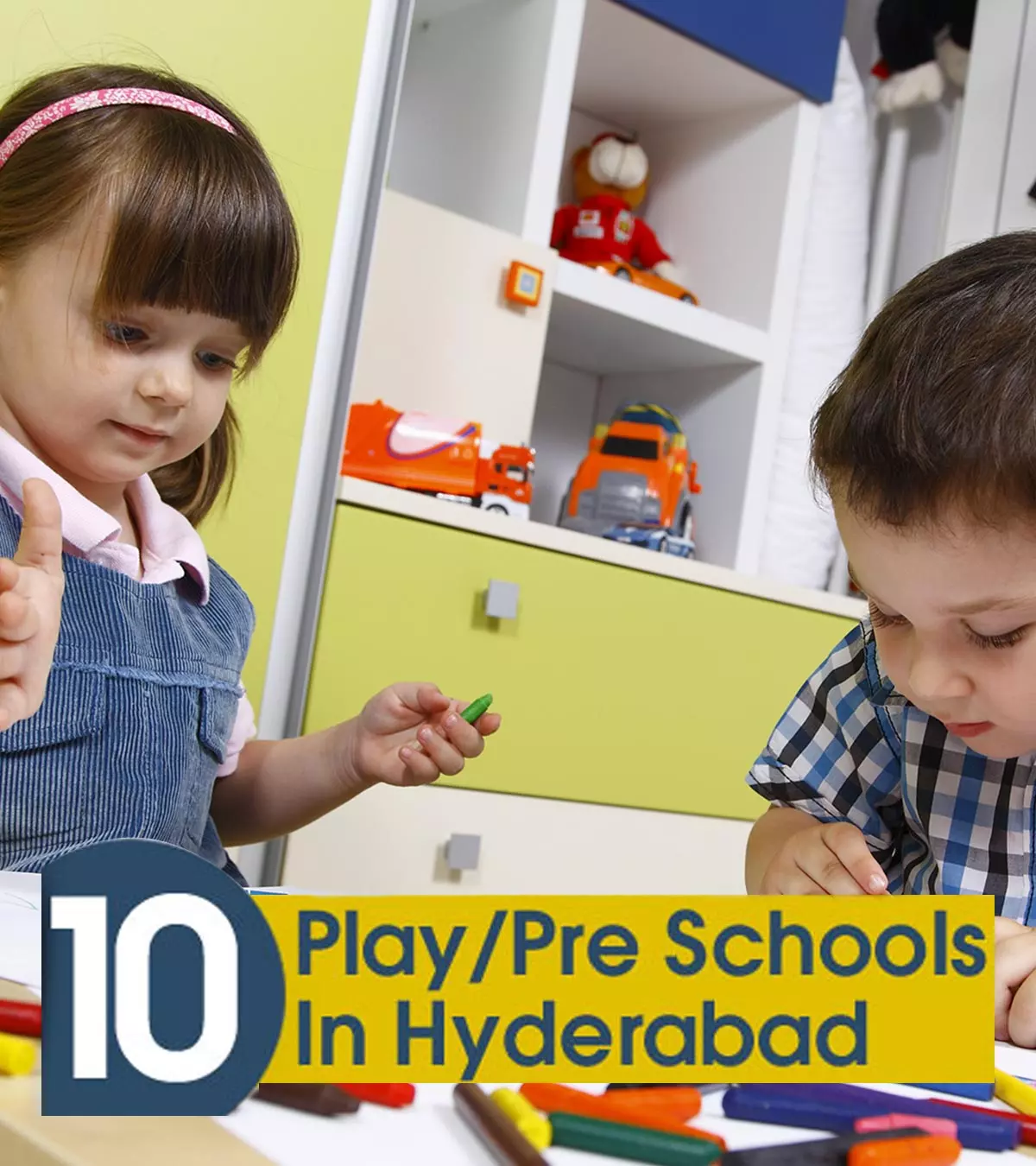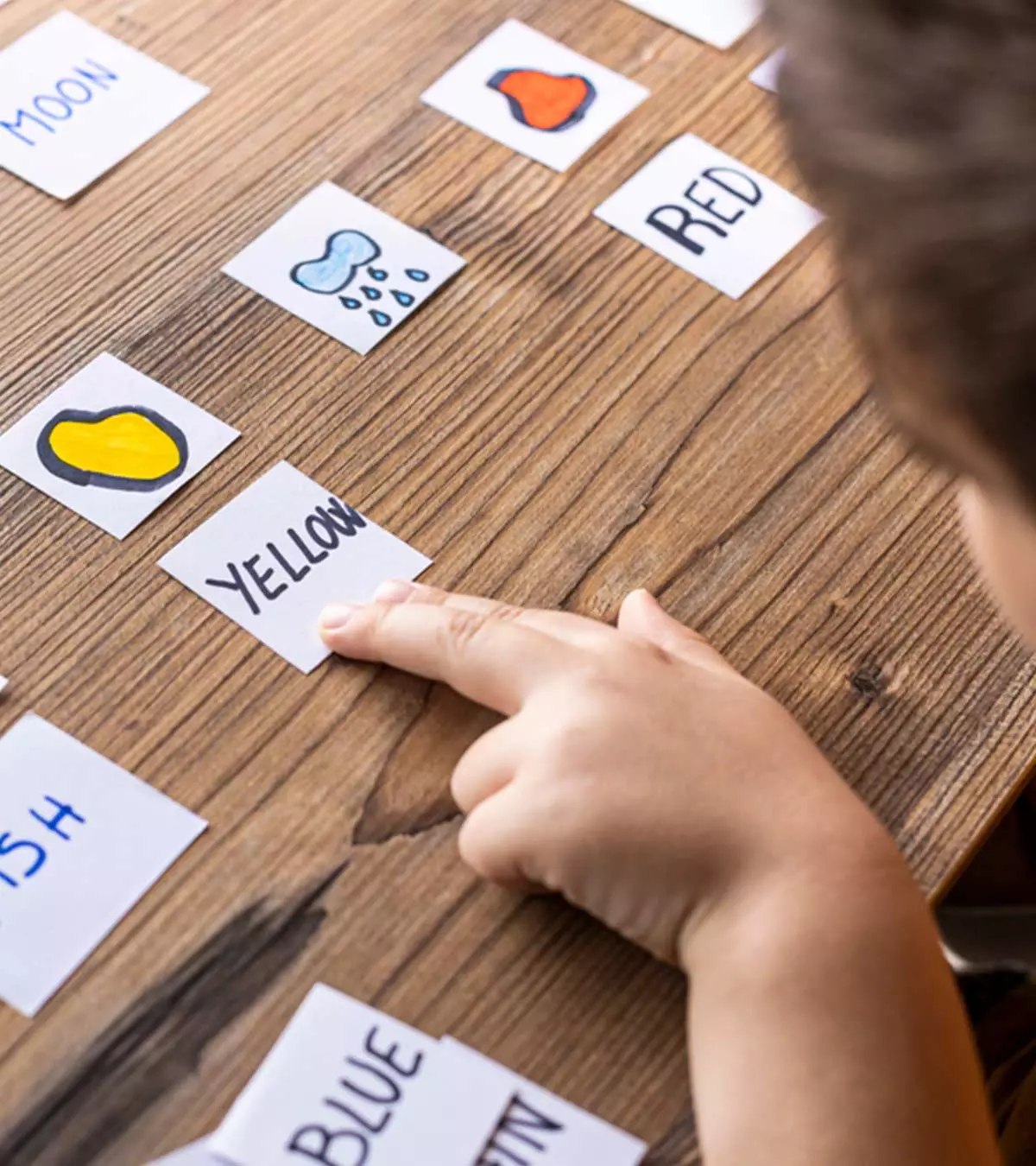
Image: Shutterstock

When you form a word with letters, it’s called spelling. Learning to spell words is an essential academic milestone that lets a child comprehend and convey their thoughts properly. Perhaps it is why several parents enquire how to teach kids to spell. Knowing the right time to introduce a child to the concept of spelling is vital to prevent overwhelming their brains with too much information.
Forming a word in English can be particularly challenging as the child has to understand several word families and spelling rules to form a grammatically correct word. Similarly, opting for age-appropriate ways to educate your child about spelling is necessary to ensure the child learns spelling words with ease. This post brings you some fun and creative ways to teach spelling to your child in a step-by-step method.
Key Pointers
- When children learn to spell, they can significantly improve their reading and writing skills.
- Learning spellings help identify learning disabilities such as dyslexia from an early age.
- If your child has difficulty spelling certain words, highlighting and explaining may help them learn them better.
Benefits Of Learning Spelling For Children
Here are some benefits of learning spelling for children (1).
1. Improves reading and writing skills

Image: IStock
Learning to spell is directly related to reading and writing well. The more words a child knows to spell, the better they can read and write.
2. Improves vocabulary
As your child learns to read and write better, they can improve their vocabulary by reading new words or even trying to spell the words you use in your daily conversations
. You can also guide your child on how to alphabetize by including games.
3. Helps diagnose learning difficulties
Making your child learn spelling can help you diagnose if your child has a learning difficulty, such as dyslexia. Early intervention can help them overcome the problem.
4. Enhances communication skills
Learning spelling enhances children’s communication skills. With a solid spelling foundation, they can construct sentences more effectively and convey their thoughts clearly in written form.
 Things to know
Things to know27 Ways To Teach Spelling To Kids
Make learning spelling fun for your children by employing any of the methods mentioned below based on your child’s mood and preference.
1. Highlight the difficult words
Children often have difficulties with specific words. If your child stumbles over a word each time, you can highlight the letters in it that confuse them and let them try again. Some of the most difficult words for them are those where “e,” “i,” and “a” occur one after the other.
For example, they might find it challenging to spell words such as receive, separate, desperate, thief, weird, and achieve. They might also trip over words with double letters, such as accommodate, address, necessary, and occasion. You can highlight these words in their notebooks and encourage them to pay close attention to them when reading. You can also help them remember the words through drill spelling or other reading games for kids.
2. Break it down into parts
The easiest way to teach spelling to children is to break up a complex word into simpler, more manageable word parts they can spell easily. You can separate the words by syllables so that they can work out how to spell the letters of each syllable and then bring them together.
For instance, you can break up the word anger into an/ger, television into te/le/vi/sion, and cycle into cy/cle.
3. Copy, copy, recall
This is a simple yet effective technique for teaching kids to spell.
In this method, you have to write down a word and draw three sections beside it. You may instruct the children to write the word in the first two sections. Next, they have to cover the two sections and write the word in the third section by recalling.
Once they have written the word unaided, they can open the covered sections and check. If it is correct, they can proceed to the next word.
4. Associate words with images

Image: IStock
Most children remember images more than they remember texts. You can use word puzzles with images while teaching spelling. Children get confused while using letters that generally have the same pronunciation and often interchange them. They often write things like “kat” or “krispy” for “cat” and “crispy” respectively.
In such cases, you can use pictures to help them with their spellings. For example, you can say, “The cat curls its tail in a C shape” and show them relevant images. Also, explain to them the rules – choose k when the vowel is e or i, and choose c for o, u, or a. C is also much more common when followed by another consonant.
5. Emphasize on pronunciation
If there are double letters in a word, emphasize them when reading, so your children also make it a habit.
For example, say ‘occasion’ by stressing on the “c” and going easy on the “s.” Similarly, for necessary, stress on the “s” and go easy on the “c.”
 Research finds
Research finds6. Make acronyms
Learning acronyms forms an essential part of education, even in colleges. Medical students remember the names of diseases or medicines using relevant acronyms. Acronyms are considered a type of mnemonic that makes it easy and fun for children to remember spellings. The best part of this exercise is that you or your children can come up with anything and have fun.
For example, cat can be the acronym for come again tomorrow.
Some other examples are:
Owl: Oh, why late?
Friend: Five rats in England need donuts.
7. Write on the palm
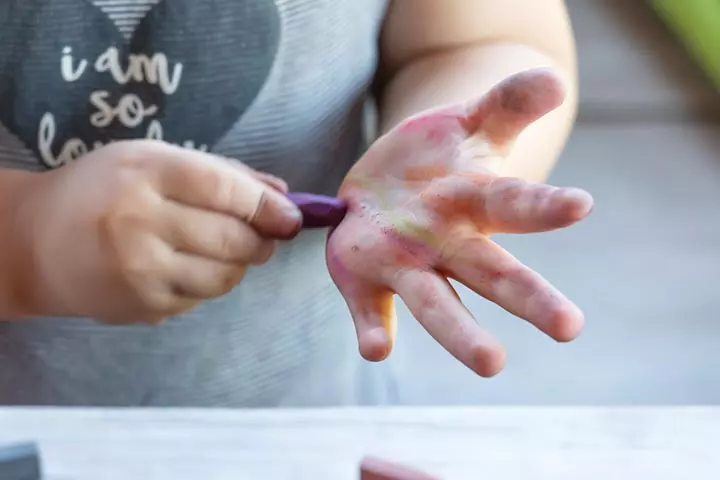
Image: IStock
Instead of writing the words on paper, ask them to trace the words on their palms (or any other part of their body). When they feel their fingers on their palm, they are creating muscle memory. With repeated “writing,” your child can memorize how a word is written.
8. Sing
Creating a melody out of a word is one of the sure-fire ways of making your child learn the spelling of the word. In fact, children participating in spelling bee competitions use this technique with great success. You can use a preset tune or create one.
The song should contain the letters of the word, and you should sing it repeatedly until it gets imprinted on your child’s mind. Once this is done, even if your child forgets the spelling, they will remember the rhythm of the word and recall the letters according to the rhythm.
9. Spell and eat
Making your child sit down to learn their spellings might seem boring to them. They would want to do something more entertaining, and learning spellings would not be on that list. However, you can tutor them in spelling during day-to-day activities, such as when having meals, so that they have fun learning.
For instance, you could ask them to spell a word and then have a bite of food. This will keep them distracted enough to learn spellings and finish what’s on the plate as well. You could also offer their favorite food sometimes as an incentive for learning their spelling.
10. Make connected words
Learning spellings will be more fun when your children play this little game with you. Tell them a word and ask them to make a new word from the last letter of your word. You can make them write the words or say them aloud. You can ask them to add words that rhyme to make it a little more fun.
One of the simplest English learning games for kids, this activity can help teach your children the pronunciation of words, particularly those with a silent letter at the beginning or end, and make them enjoy playing with words.
 Quick tip
Quick tip11. Make videos
If you do not have the time to be with your child while they are learning their spelling, you can record a video on your phone. Record videos of you spelling out the letters first, followed by your child repeating them.
When your child watches it enough times, they will be able to write the word effortlessly.
12. Create flip cards
You can also indulge your child in creating flip cards. You can print the image of the word behind the letters that make the word. For example, print the image of cats behind the letters C, A, and T. Let the child find the different letters with cat images and assemble them to form the word. Create word jumbles with the cards and let them arrange them in order.
You can also come up with your own ways to teach spellings to your kids. Mandy, a mother and teacher, explains how sand writing words by tracing them helped her students improve their spellings. She says, “So this was something that I used in the classroom a lot with my younger students and it helped so much…This is a great way for them to get in those fine motor skills but also get them those spelling skills as well (i).”
13. Search for words
Word searches are perfect for teaching kids to spell. They teach your children different ways to look at letters and form words out of them. Give them a grid with an assorted set of words. Use a timer to make it more fun and watch them as they race against time to find new words.
You can also use books, magazines, or newspapers for a word search. Give your child a particular word and ask them to mark the occurrences of the word on a page or a paragraph. This game will sharpen their brains and improve their comprehension skills as well.
14. Pass the ball
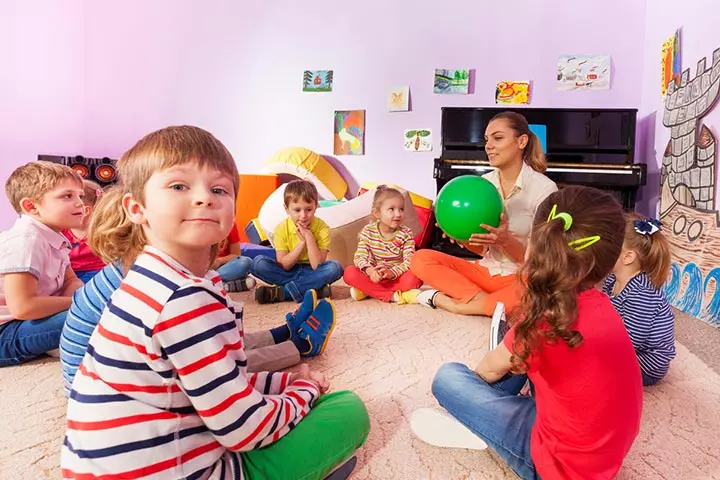
Image: IStock
When you have a group of children with you, you can play this game to teach them spelling. Say a word, and the children have to stand in a circle and pass a ball to each other while they chant a letter each.
If a child says a wrong letter, the next player throws back the ball to them and waits until they say the correct letter. The game guarantees a lot of laughter while also making them learn effortlessly.
15. Play scrabble
You need not necessarily play Scrabble with your children, but you can use the alphabet tiles in Scrabble or Crosswords to let your children make words. They can even calculate the points on the tiles as their score. This is also an excellent way to teach them words and numbers.
Scrabble is fun as it teaches children to make new words using the same letters. For example, C-A-T can also be written as A-C-T. If they add a K, they can form the word T-A-C-K.
16. Use mobile phones
Studying might be boring for children, but give them a phone, and they will be happy for hours on end. You can use this to your advantage. Try different spelling games that are suitable for children. Install a couple of these games, and let them navigate through different levels by spelling new words.
These games and puzzles help children learn and memorize new words, and they will be spelling complex words in no time.
17. Make flashcards
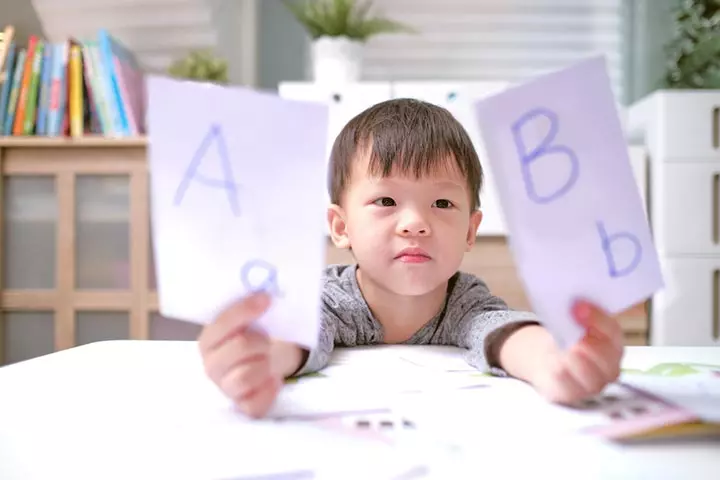
Image: IStock
Use age-appropriate flashcards to teach spellings to children. Teachers at preschools often use flashcards to teach children new concepts. You can use flashcards to teach spelling, reading, and writing skills to children.
Write words on the cards and read each word aloud. Let the child write the word on the back of the card and then check it together. For reading, lay out some flashcards with letters to form a word and ask your child to pick the image that matches the word. For writing, let the child trace the word over the card using tracing paper and then write it on another card without any assistance.
 Trivia
Trivia18. Color the words
Children love playing with colors. So, why not introduce some colors in the world of words? Write some words in a big cartoonish font so that they can be colored, and let your children go wild coloring them.
If you are good at drawing, you can draw objects and ask your children to color them and then spell them. This way, they will have a magical, colorful time with words and also learn their spellings. You can even cut and paste these colored words onto a word wall.
19. Play word bingo
Bingo can help your children master basic spelling skills. Don’t believe it? Trust us. All you have to do is create a grid and write different letters in different boxes. Read out words and tell your children to circle the letters that occur in each word. The first one that gets a full house wins.
You can also use bingo to teach reading to your children. Swap the letters with words and ask your children to circle those words you read out.
20. Spell with stairs
Make climbing up and down the stairs a learning activity. You might have already made them count the steps each time they ascend and descend. Now, you can ask them to spell out words on the steps.
Make them say a letter of a word as they climb each step. For younger children, you can even spell out three to four words. Step on the stair, say out a letter, then proceed to the next.
21. Group similar words
Instead of teaching children seemingly different words and spellings, group similar-sounding words (homophones) or those that have similar spellings and make a list. This way, your child will be able to visualize one word and automatically associate it with other words.
For example, words such as high, sigh, nigh, light, and sight have “igh” in common. Write them down, and ask your child to spell each word aloud. They will be able to remember their spellings better.
22. Cut out words
If you don’t have a Scrabble set at home and do not want to buy one either, make some word tiles yourself. Take a magazine or newspaper and cut out letters in bigger fonts for easier handling. Paste them on construction paper or an empty cereal box and cut them out.
Give these letters to your children and let them experiment with them to form new words. You can also teach them to pronounce the words while they are creating them.
23. Use computer applications
Applications such as Microsoft Word and Grammarly are pretty helpful for quick spell checks. While they are intensively used by adults, they can also be used by children to learn spellings. Ask your child to type a word and check whether it is spelled correctly.
You can also use an online dictionary or other applications for puzzles and word games for kids to improve your child’s spelling, reading, and comprehension skills.
24. Use creativity
Writing on a sheet of paper using a pencil is standard for children. As they have notoriously small attention spans, it won’t be long before they find something more interesting to do.
You can let them explore the world of letters by letting them be as creative as they want. Give them colors and encourage them to draw and paint words. They can also create a word collage using cuttings from magazines or try their hand at calligraphy.
25. Read more
Last but not least, read more to your children. The more you read to your children or the more they read, the richer their vocabulary. They learn words and their pronunciations by sight and sound.
You can select stories or poems that contain words that you want them to learn. By repeating stories, you help improve their spelling skills while also firing their imagination.
26. Dictation
Dictation is an effective method for teaching children spelling as it engages them in listening and writing simultaneously. This process reinforces the connection between spoken and written language, helping children understand and remember correct spellings. Hearing and spelling words can help children understand language patterns, which improves their overall spelling proficiency.
27. Word chain
Word chain is an excellent tool for teaching spelling to children. It turns learning into a fun, interactive game where each word begins with the last letter of the previous word. This interactive approach engages children and encourages them to think about letter patterns and word structures. It fosters their vocabulary, spelling skills, and cognitive flexibility, making learning easy and effective.
Frequently Asked Questions
1. What age should a child be able to spell?
Children may start to spell their names and simple words by five to six years of age (2). Some children may learn sooner than others.
2. What part of the brain is responsible for spelling?
The left hemisphere of the brain is considered responsible for spelling (3).
3. Why is it easier to read words than to spell them?
Spelling words may seem more complicated than reading, as sounds can be spelled in many ways. It needs more practice to spell than to recognize or read the words (4).
4. Why is my child struggling with spelling?
A child may find it difficult to spell if they are not practicing enough. However, if the difficulty persists despite all efforts, it may indicate certain disorders such as dyslexiaiA learning disorder in children associated with reading and writing difficulty. , dysgraphiaiA writing disability in children that causes the letters to be wrongly formed. , and attention deficit hyperactivity disorder (ADHD)iA neurodevelopmental disorder affecting a child's ability to concentrate and manage energy levels. . Consult a doctor to identify the cause (5) (6).
How to teach your kid to spell is a common concern of many parents and caregivers when their children are ready to learn languages. Learning spelling can improve the child’s vocabulary, reading, writing, and communication skills. This may also help diagnose certain learning disorders at a young age and helps modify the learning process to tackle the disability. You may highlight the difficult words, break them down, and teach the spelling. Good knowledge of phonetics, associating words with images, copying, and recall can help children learn to spell.
Infographic: Spelling Games For Children
Children often find it interesting when learning is combined with entertainment. So, if teaching spellings seem monotonous, try incorporating unique games into it and watch how easy and fun the learning becomes. This infographic is specially designed to give you some ideas on introducing spelling games for children.
Some thing wrong with infographic shortcode. please verify shortcode syntax
Master the art of assisting children in improving their spelling skills with this invaluable video resource. Discover tips and tricks to make spelling easier for kids.
Personal Experience: Source
MomJunction articles include first-hand experiences to provide you with better insights through real-life narratives. Here are the sources of personal accounts referenced in this article.
i. How to teach spelling | 10 creative and fun ways | teach spelling in our homeschool;https://www.youtube.com/watch?v=onkSaruq7HI&t=38s
References
1. Reed, D. K; Why teach spelling?; RMC Research Corporation, Center on Instruction (2012).
2. Toddlers begin learning rules of reading, writing at very early age, study finds; Washington University in St. Louis.
3. Brenda Rapp and Kate Lipka; The Literate Brain: The Relationship between Spelling and Reading; National Library of Science (2011).
4. Spelling and Reading: How Are They Connected?; Hill Learning Center.
5. Disorders of Reading and Writing; American Speech Language Hearing Association.
6. Anna Maria Re et al.; Spelling errors among children with ADHD symptoms: the role of working memory; National Library of Science (2014).
7. What are some signs of learning disabilities?; National Institute of Child Health and Human Development (2018)
8. Helene Moller et al.; Effects of Integrated Spelling in Phonics Instruction for At-Risk Children in Kindergarten; Reading and Writing Quarterly, Volume 38, Issue 1 (2025).
Community Experiences
Join the conversation and become a part of our nurturing community! Share your stories, experiences, and insights to connect with fellow parents.
Read full bio of Beth Sullivan
Read full bio of Bharathi V
Read full bio of Harshita Makvana
Read full bio of Kavita Kankani















